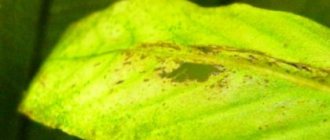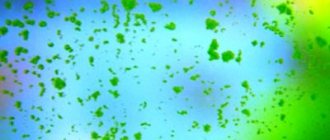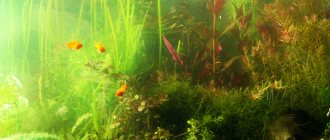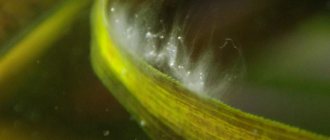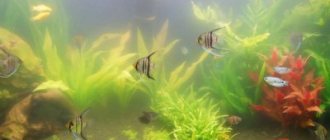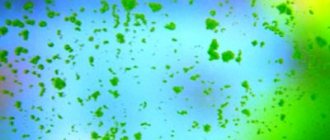0
(0)
Aquarium problems are not limited to beginners only. Even those who have kept fish for many years encounter them. After all, the main attention is paid to them, and other plant neighbors are often forgotten. But in vain! After all, the overall well-being of the aquarium depends on their condition. If undesirable changes occur in aquatic plants, it means that there is a failure in the chain of biological balance. One of the most common phenomena is blackening. We will tell you what they are, why they appear, and what needs to be done to eliminate them in our article.
Ways to fight
Options for combating black beard in an aquarium are divided into chemical and biological. When using the chemical method, medications are used - they cope with the scourge quite quickly, but at the same time they can harm the fish, so we will dwell in more detail on all possible methods of control.
Population of certain varieties of snails and fish
As is known, ordinary catfish, ancistrus catfish, as well as Siamese algae eaters and carp-toothed fish eat blackbeard. At the same time, you should keep in mind that it is quite tough, so they will not just start feeding on it. When treating a pond, it is better not to give any other food to the inhabitants of the aquarium , only in this case will they turn their attention to black filamentous algae. As for snails, a possible solution to the problem would be to add a small handful of small ampularia into the aquarium - they do an excellent job with any type of algae.
But immediately after the enemy is destroyed, it is advisable to remove the ampularia from the water, otherwise they will quickly move on to higher plants.
Plant repopulation
It has been noted that placing hygrophila, elodea and lemongrass, as well as hornwort, vallisneria, nayas and Indian rotala in a tank helps to remove black beard. The point here is that the algae first of all attacks the simplest plants, while the higher ones, with rapid development, begin to actively absorb useful substances. To do this, you should purchase as many seedlings as possible and create favorable growth conditions for them. It would be useful to use special fertilizers containing iron and manganese. During the growth process, plants need to be pruned, since young shoots more actively absorb useful components from the water.
Under these conditions, the black beard is not very comfortable; its hairs lighten and then die all over.
General rules for maintaining balance in an aquarium
Achieving complete biological equilibrium in an artificial reservoir is difficult, but possible.
Normally, a reservoir, like a natural body of water, must maintain the circulation of substances.
All dead remains must be broken down by beneficial bacteria and reduced to substances that can be consumed by plants, then produce energy through photosynthesis and again produce biological matter - most often starch and polysaccharides. Next, the fish eat plants, digest the organic matter of their relatives, if they are predators, build their body from amino acids, produce waste - and the process begins again.
Nitrifying bacteria are responsible for this balance. When they die as a result of the development of harmful algae, dangerous processes can move up the food chain: the death of one group of microorganisms can cause disease and death of fish.
Basic principles of maintaining balance in an aquarium:
- refusal to use fertilizers and antibiotics without good reason;
- regular cleaning and water changes in compliance with all the rules for carrying out these manipulations;
- proper feeding of fish and maintaining their health;
- compliance with quarantine before adding new pets to a common aquarium;
- constant testing and monitoring of water quality;
- loosening the soil, improving living conditions for nitrifying bacteria.
In nature, everything is harmonious, so the balance is established by itself, our task is just not to disturb it inadvertently or intentionally.
Brown algae
Unsightly plaque on plants can appear due to the active growth of brown algae. Growing over the leaves, they impair the nutrition of representatives of the underwater flora and reduce the level of light. The reasons for the contamination of a reservoir with brown algae and compsopogon are similar, therefore the methods of dealing with them are the same:
- Clean the walls of the tank with a scraper or blade. Do not use a foam sponge as it will only contaminate the water.
- Gently rub the leaves and stems of the plants with your fingers.
- Remove large stones from the aquarium and rinse with running water.
- Lightly loosen the sand or gravel and collect the algae fragments that have settled to the bottom with a soil cleaning hose.
In the future, you need to take care of a sufficient number of higher plants that will prevent the growth of a colony of brown algae. Also recommended:
- Observe daily fish feeding standards. There should be no particles of dry food remaining in the water, which are a breeding ground for weed algae.
- Add Ancitrus, Otocinclus or other cleaners to the aquarium.
- Control the level of mineral compounds, acidity and hardness.
Particular attention should be paid to lighting and water heating. The growth of brown algae is provoked by cool weather, poor lighting and insufficient daylight hours. It is worth raising the water temperature to +22...+28°C, increasing the power of the lamps and extending their operation to 10-12 hours a day, and the problem with algae will go away. To get rid of a colony of organisms, you need to use LB brand fluorescent lamps - the red rays of their spectrum are destructive to algae, but beneficial to higher plants.
What could it be?
The brown coating in the aquarium is of organic origin and is caused by the vital activity of aquatic microorganisms - diatoms (bacillaria, diatoms, diatom plankton). Diatoms are the oldest microorganisms on the planet that are capable of consuming and processing any organic material. This is due to the rapid and widespread spread of the bacillaria along the walls of the aquarium, plants and decorations inside it.
Colonies of diatoms have a gliding movement and can cause significant damage to the entire aquarium in a matter of days. Brown plaque on leaves disrupts photosynthesis reactions and contributes to plant death.
The unpretentiousness of plankton contributes to the appearance of plaque on the ground, stones, glass and leaf surfaces. On the first day, the plaque is barely noticeable; in subsequent days, the lesion progresses, covering ever larger areas, and the plaque becomes much darker (even black).
Their cells contain toxins and aggressive acids (domoic acid), which can lead to poisoning of humans and animals upon contact with contaminated water. Diatoms themselves are a source of nutrition for more complex plants (for example, blackbeard). Brown algae can completely infect an aquarium in 7-10 days and cause the death of all its vegetation.
Diseases associated with algae
Blackbeard algae is the most common disease. They face it the most. This algae in the form of black hairs settles not only on the walls of the aquarium, but also on the vegetation. In addition to the ugly aesthetic appearance, it significantly slows down growth. The causative agent of this disease can be introduced with new plants or be in the stomach of fish. To prevent blackbeard algae from getting into the aquarium, it is better to purchase plants that are known to be clean.
How to get rid of it? Mechanical cleaning should be carried out using a stiff brush. In case of severe disease damage, it is better to replace the vegetation with fast-growing ones. Floating plants can be kept in a solution with hydrogen peroxide at the rate of 1 ml per liter of water. Limit fish feeding. It is advisable to feed them live food every other day. Change 30% of the water twice a week. If this does not help, purchase a ready-made drug at a pet store.
Red algae (purple algae). A sign of scarlet blight is the appearance of small tufts or individual red hairs on the leaves. As a rule, this sore appears in cold-water aquariums. Catfish and ancistrus help in the fight against it.
Blue-green algae. The disease begins with the appearance of dark green dots. They cover the soil, the walls of the aquarium, and sheets. Over time, the dots grow, forming a dense
crust, which is then very difficult to remove. Plants slow down and individual leaves begin to rot. There can be several reasons for the appearance of blue-green algae: unstable water, excessively strong lighting, elevated temperatures, poor aeration of water, introduction with live food.
To get rid of blue-green algae, you need to thoroughly clean the plants, walls and bottom of the aquarium. You can get inhabitants that feed on green fouling. Increasing water aeration and decreasing illumination also has a positive effect on the fight against them. As a last resort, penicillin should be used.
Video on the topic
Watch a video about brown plaque in an aquarium:
The brown coating in the aquarium is due to the manifestation of the vital activity of diatoms . The defeat is typical for both new and balanced aquariums and can lead to complete contamination and death of aquarium plants within 2 weeks. Simple rules for caring for and feeding fish will allow you to prevent damage to the aquarium inhabitants and quickly get rid of brown plaque without harming the inhabitants of the aquarium.
There is always plaque in any aquarium. The only difference is whether this coating will be a single speck on the entire aquarium or will cover aquarium plants and decorations in a thick layer.
Many people do not pay attention to single spots of plaque of any color and reach a situation where the aquarium is completely affected by plaque.
Relatively speaking, plaque, based on its origin, is divided into two types:
- Plaque of biological origin
- Plaque in the form of chemical deposits of salts
- Green plaque
- White plaque
- Black plaque
- Brown plaque
- Brown plaque
Plaque of biological origin is tiny algae or microorganisms that cover aquarium equipment and plants with a thin layer of some color. Most often, plaque is described by color, and aquarists identify the following colors:
Chemical plaque includes the appearance of limescale, which is not of a living nature, but which many beginners confuse with white plaque of bacterial origin.
Plants turn black, why? Photo is avaiable
Please help me determine why plant leaves turn black?
Jebo aquarium 67 liters, age 5 months, original filter in the lid (ceramics and synthetic padding), 2 lamps of 15 watts (one white Jebo, the other Gro lux), light on for 12 hours, filtration and aeration around the clock, population: 12 medium-sized barbs, 2 synadonics and 1 SAE. Once a month liquid fertilizer Planta Min, weekly water change 20% with a siphon. Plants: 1) Ludwigia (the old leaves are covered with a black coating and fall off, the young shoots are shriveled) 2) Thai fern (there is a black coating on the leaves, and the young ones seem to have been gnawed) 3) Ehi (black coating and holes) 4) Rotala (the tops remain ) 5) Sinema (started to turn black) 6) Hornwort and Java moss are growing well 7) Indian fern (I planted it yesterday, but the next morning it’s all full of holes! There are no snails, fish don’t touch the plants, I’m watching).
Other aquas are 1-2 months younger, everything is fine there with stretching. Strange!
Yes, I probably won’t turn off the aeration completely, I’m afraid for the fish, I’ll just turn it down a little during the day. I also wanted to ask, maybe I could put balls of blue clay under the roots? Or is there enough plantamine?
. since you don't have CO2 etc. But turning off aeration can lead to an improvement in the condition of the plants.
It is precisely because there is no CO2 that aeration can be useful, since there is much more of it in the air than in water. And at night, aeration is also needed, because... Oxygen is necessary for breathing not only for fish, but also for plants for normal growth.
I wrote, 10 (=0.5 ml) drops per day. I proceeded from the volume of your aquarium and the condition of the plants. I think that you will not need to increase the dose of plantamine in the future, since you do not have CO2, etc. But turning off aeration can lead to an improvement in the condition of the plants.
Change one lamp for now.
I will only have to change one original one, and I installed Gro lux only two months ago. Or is it impossible to change one lamp at a time? What if you change both at once? Oh, another question: if you add plantamin EVERY day, how many drops?
To all that was said by DimaMtl. Replace the lamps with new ones (change on average every 5-6 months) no matter what they are shining.
Thanks a lot! I'll try to do everything as you said, I hope it improves, then I'll post pictures.
Plantamine cannot be used like this; it must be added dropwise every day (everything is written incorrectly in the instructions). It is also impossible to siphon the soil every week. My opinion is that as a result of weekly siphoning you have a severe deficiency of nitrogen and phosphorus. 2 as a result of using plantamine you have a peak iron overdose, and then iron starvation
Why does plaque appear?
The reason for the appearance is neglect of aquarium maintenance or improper maintenance of the aquarium. If an aquarist neglects regular maintenance of the aquarium, which consists of weekly water changes and cleaning the soil of accumulated debris, then the biological balance in the aquarium is shifted. Shifted biological balance inhibits the vital activity of aquarium plants and fish. There is a simple pattern: the worse aquarium plants feel, the better simple unicellular algae feel.
The bottom line is that aquarium plants compete with algae for nutrients. Thanks to the branched root system, aquarium plants more efficiently consume beneficial microelements and minerals contained in aquarium water and soil.
Algae, deprived of most of their nutrition, are suppressed, which affects their numbers and reproduction rate.
In a dirty aquarium, a displaced biological balance and a disrupted nitrogen cycle lead to the appearance of substances that are not consumed by aquarium plants, but serve as food for microorganisms and algae, which leads to an outbreak of growth in their number.
As a result: aquarium plants are oppressed by poor water and lack of nutrients, while algae and microorganisms thrive and multiply rapidly.
Incorrect actions by the aquarist that lead to the appearance of plaque include the following:
- Applying excessive amounts of fertilizer for aquarium plants
- Excessive or insufficient lighting
- Excessive feeding of aquarium fish
- Excessive number of fish and overpopulation of the aquarium
- Insufficient number of aquarium plants
Applying excessive amounts of plant food leads to the fact that aquarium plants do not absorb such a large amount of nutrients, and the nutrients in large quantities go to the simplest algae, which provokes an outbreak of their growth.
Excessive lighting provokes the appearance of green algae, which is expressed in the appearance of a green coating and green water. Insufficient lighting leads to the appearance of brown or brown algae. Accordingly, brown or brown plaque.
Excessive feeding of fish leads to the appearance of rotting food at the bottom of the aquarium, which leads to general rotting of the aquarium, an outbreak of algae growth and the appearance of a white bacterial coating.
An excessive number of fish and overpopulation of the aquarium leads to a large amount of waste, which the aquarium’s nitrogen cycle cannot process. Additionally, the situation is aggravated by the lack of regular maintenance of the aquarium.
An insufficient number of aquarium plants leads to an excess of nutrients in the aquarium, which causes the emergence and development of various algae.
Inappropriate lighting and heating modes
The temperature and lighting of the aquarium are the most important factors not only for fish. The normal development of aquatic plants depends on these conditions. Only with optimal indicators is normal transpiration and assimilation possible.
Transpiration is the movement of water through plant organs and its evaporation from surface tissues.
Assimilation of aquatic plants is a nutritional process that occurs with sufficient heat, light and carbon dioxide. Only under these conditions does the synthesis of the necessary protein and the absorption of macro- and microelements occur.
“Atlas of aquarium plants” - K. Kasselman, (translation from German - M.: Aquarium-print, 2004.)
Any error in at least one of the three components leads to disruption of plant respiration and nutrition. As a result, the plant lacks nutrients.
- Full growth of aquarium plants is possible at optimal temperature and lighting.
Most often, when undesirable signs appear on aquatic plants, the cause is sought in lighting or water quality, and the temperature is forgotten. But in vain!
The most popular aquarium flora originates from tropical heat-loving plants. The extremely low temperature for them is +200 – +220. Many fish and plants thrive at +240 – +260.
Important! But these indicators cannot be universal. For each species of animal and plant life, it is necessary to select an individual regime. Naturally, they must match.
Most popular plants require aquarium soil and substrate. This is a source of nutrition that provides the necessary substances. It is selected taking into account the biological characteristics of plants.
Reasons for appearance
The reasons for the appearance of a black beard in an artificial reservoir are as follows:
- excess nitrogen compounds and phosphates in water;
- high acidity and hardness;
- overpopulation;
- overfeeding fish;
- frequent siphoning of soil;
- the presence of burrowing fish in the aquarium, which lift organic sediment from the bottom;
- rare water changes;
- poor filtration;
- placing infected plants or decorative elements in an aquarium without prior disinfection and quarantine;
- dim lighting;
- strong current created by the filter;
- high oxygen content in water and lack of carbon dioxide.
Symptoms of phosphorus deficiency
Changes in the color of aquatic plants can occur due to improper feeding or its complete absence. Poor health can be caused by a deficiency or excess of macro- and microelements.
- In particular, the blackening of leaves is caused by a lack of phosphorus. The symptoms that appear in this case are a sharp darkening of the color of the leaves. The dark green shade becomes so saturated that it looks brown-black.
- Excessive nitrogen content gives a similar picture.
Caring for decorative elements
To prevent the life of fish from turning into a nightmare, it is important to regularly clean the interior items of their home (figurines, shells, stones, driftwood, grottoes). It is convenient to use a sponge or toothbrush for this. Soap, soda or bleach (low concentration) are suitable as cleaning compounds.
We suggest you read How to remove an inscription from a bag
Laundry soap solution:
- Place the decorations in the cleaning solution for 15 - 20 minutes.
- Then rub and rinse.
Hydrogen peroxide:
- Combine with water in a ratio of 1:10.
- Soak interior items for 15 minutes.
- Rinse with clean water.
Bleach "Whiteness":
- The product perfectly cleans stones, artificial corals, and ceramics.
- Prepare the solution using a separate container (proportion 1:10).
- Soak the decor for 1-2 hours.
- Then rinse thoroughly until the bleach smell disappears.
Baking soda:
- To clean stones, wet them.
- Sprinkle with the substance and rub with a brush.
- Leave for 30 minutes.
- Then rub again and wash off the soda.
Aphid
Another problem that aquarists face is aphids on floating plants, which feed on their sap, slow down growth and can lead to death. The pest appears when there is improperly organized lighting, dense plantings, and a lack of carbon dioxide.
In order to get rid of aphids, infected plants must be transferred to another container for quarantine. It is very important that the vessel is in the shade, since most often the lack of lighting and high humidity is quite enough to get rid of the pest.
To speed up the process, you can spray the plants with a solution of copper sulfate (1 g), soap (20 g) and water (1 l).
Now you know that an imbalance of nutrients, improper lighting, dense plantings, poor aeration and filtration can lead to vegetation diseases. Proper care of the aquarium, timely water changes and fertilizing are the best preventive measures to prevent the occurrence of diseases and pests.
Was this article helpful? Yes No Has already helped 30 times
Aquarium plants Aquarium Breeding aquarium plants
Poor quality primer or substrate
One of the reasons for the malaise is the discrepancy between the characteristics of the nutrient medium and the requirements of the plants. Most often this happens when making homemade substrates. Creating an optimally balanced environment for plants is quite difficult. Some novice aquarists use available products. To the point where they take ordinary garden soil. This is unacceptable, because it necessarily contains pathogenic microorganisms that cause disease.
Tip #1 . Don't take the risk! It is better to use soils intended for aquarium plants. The packaging usually states what types of aquatic flora it is suitable for.
- Ready-made soils contain useful nutrients necessary for plants.
To ensure normal, healthy growth of aquarium flora, manufacturers offer special substrates. They contain the entire range of essential nutrients. It is laid before the tank is filled with water. Depending on the manufacturer, the substrate layer can be from 1 cm to 3 cm. Ordinary soil is placed on top.
A properly formed nutrient medium provides plants with the necessary macro- and microelements. If there are not enough of them, this will cause weakening of the plants. As a result, blackening may occur. Let's take a closer look at what happens when there is a shortage of certain elements.
